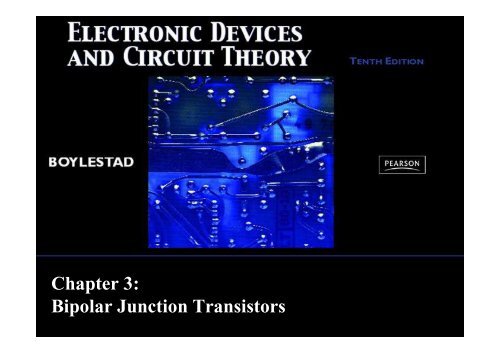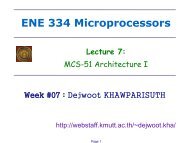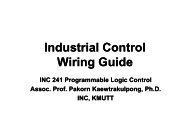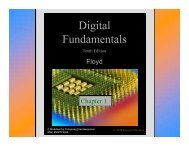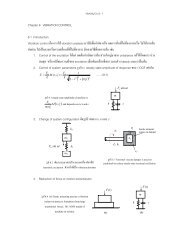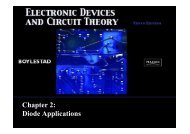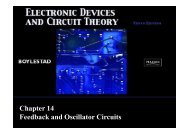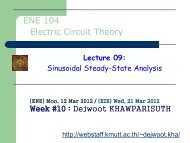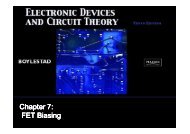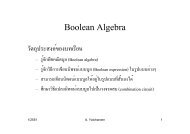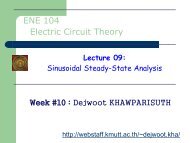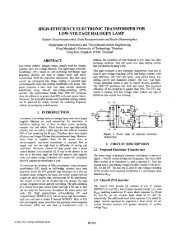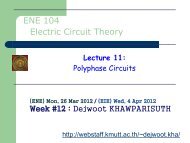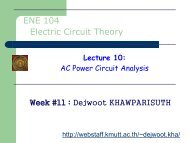Chapter 3: Bipolar Junction Transistors - Webstaff.kmutt.ac.th
Chapter 3: Bipolar Junction Transistors - Webstaff.kmutt.ac.th
Chapter 3: Bipolar Junction Transistors - Webstaff.kmutt.ac.th
- No tags were found...
Create successful ePaper yourself
Turn your PDF publications into a flip-book with our unique Google optimized e-Paper software.
<strong>Chapter</strong> 3:<strong>Bipolar</strong> <strong>Junction</strong> <strong>Transistors</strong>
Transistor ConstructionThere are two types of transistors:• pnp• npnpnpThe terminals are labeled:• E - Emitter• B - Base• C - CollectornpnElectronic Devices and Circuit Theory, 10/eRobert L. Boylestad and Louis Nashelsky2Copyright ©2009 by Pearson Education, Inc.Upper Saddle River, New Jersey 07458 • All rights reserved.
Currents in a TransistorEmitter current is <strong>th</strong>e sum of <strong>th</strong>e collector andbase currents:IE= IC+IBThe collector current is comprised of twocurrents:IC= IC+majorityICOminorityElectronic Devices and Circuit Theory, 10/eRobert L. Boylestad and Louis Nashelsky4Copyright ©2009 by Pearson Education, Inc.Upper Saddle River, New Jersey 07458 • All rights reserved.
Common-Base ConfigurationThe base is common to bo<strong>th</strong> input (emitter–base) andoutput (collector–base) of <strong>th</strong>e transistor.Electronic Devices and Circuit Theory, 10/eRobert L. Boylestad and Louis Nashelsky5Copyright ©2009 by Pearson Education, Inc.Upper Saddle River, New Jersey 07458 • All rights reserved.
Common-Base AmplifierInput Char<strong>ac</strong>teristicsThis curve shows <strong>th</strong>e relationshipbetween of input current (I E ) to inputvoltage (V BE ) for <strong>th</strong>ree output voltage(V CB ) levels.Electronic Devices and Circuit Theory, 10/eRobert L. Boylestad and Louis Nashelsky6Copyright ©2009 by Pearson Education, Inc.Upper Saddle River, New Jersey 07458 • All rights reserved.
Common-Base AmplifierOutput Char<strong>ac</strong>teristicsThis graph demonstrates<strong>th</strong>e output current (I C ) toan output voltage (V CB ) forvarious levels of inputcurrent (I E ).Electronic Devices and Circuit Theory, 10/eRobert L. Boylestad and Louis Nashelsky7Copyright ©2009 by Pearson Education, Inc.Upper Saddle River, New Jersey 07458 • All rights reserved.
Operating Regions• Active – Operating range of <strong>th</strong>eamplifier.• Cutoff – The amplifier is basicallyoff. There is voltage, but littlecurrent.• Saturation – The amplifier is full on.There is current, but little voltage.Electronic Devices and Circuit Theory, 10/eRobert L. Boylestad and Louis Nashelsky8Copyright ©2009 by Pearson Education, Inc.Upper Saddle River, New Jersey 07458 • All rights reserved.
ApproximationsEmitter and collector currents:IC≅IEBase-emitter voltage:VBE=0.7V (for Silicon)Electronic Devices and Circuit Theory, 10/eRobert L. Boylestad and Louis Nashelsky9Copyright ©2009 by Pearson Education, Inc.Upper Saddle River, New Jersey 07458 • All rights reserved.
Alpha (α)Alpha (α) is <strong>th</strong>e ratio of I C to I E :α =dcICIEIdeally: α = 1In reality: α is between 0.9 and 0.998Alpha (α) in <strong>th</strong>e AC mode:α∆IC∆IEElectronic Devices and Circuit Theory, 10/eRobert L. Boylestad and Louis Nashelsky<strong>ac</strong> = 10Copyright ©2009 by Pearson Education, Inc.Upper Saddle River, New Jersey 07458 • All rights reserved.
Transistor AmplificationCurrents and Voltages:IEICILVL=≅≅=IiIEIi=I RLViRi== 10 mA200mV20Ω= ( 10 ma)(5 kΩ)= 10mA= 50 VVoltage Gain:A vV=LVi=50V =200mV250Electronic Devices and Circuit Theory, 10/eRobert L. Boylestad and Louis Nashelsky11Copyright ©2009 by Pearson Education, Inc.Upper Saddle River, New Jersey 07458 • All rights reserved.
Common–Emitter ConfigurationThe emitter is common to bo<strong>th</strong> input(base-emitter) and output (collectoremitter).The input is on <strong>th</strong>e base and <strong>th</strong>eoutput is on <strong>th</strong>e collector.Electronic Devices and Circuit Theory, 10/eRobert L. Boylestad and Louis Nashelsky12Copyright ©2009 by Pearson Education, Inc.Upper Saddle River, New Jersey 07458 • All rights reserved.
Common-Emitter Char<strong>ac</strong>teristicsCollector Char<strong>ac</strong>teristicsBase Char<strong>ac</strong>teristicsElectronic Devices and Circuit Theory, 10/eRobert L. Boylestad and Louis Nashelsky13Copyright ©2009 by Pearson Education, Inc.Upper Saddle River, New Jersey 07458 • All rights reserved.
Common-Emitter Amplifier CurrentsIdeal CurrentsI E = I C + I BI C = α I EActual CurrentsI C = α I E + I CBOwhere I CBO = minority collector currentI CBO is usually so small <strong>th</strong>at it can be ignored, except in highpower transistors and in high temperature environments.When I B = 0 µA <strong>th</strong>e transistor is in cutoff, but <strong>th</strong>ere is some minoritycurrent flowing called I CEO .ICEOICBO1−α=IB=0µAElectronic Devices and Circuit Theory, 10/eRobert L. Boylestad and Louis Nashelsky14Copyright ©2009 by Pearson Education, Inc.Upper Saddle River, New Jersey 07458 • All rights reserved.
Beta (β)β represents <strong>th</strong>e amplification f<strong>ac</strong>tor of a transistor. (β issometimes referred to as h fe , a term used in transistor modelingcalculations)In DC mode:β =dcI CI BIn AC mode:β∆I∆IC=CE<strong>ac</strong> V =constantBElectronic Devices and Circuit Theory, 10/eRobert L. Boylestad and Louis Nashelsky15Copyright ©2009 by Pearson Education, Inc.Upper Saddle River, New Jersey 07458 • All rights reserved.
Beta (β)Determining β from a GraphβAC(3.2mA=(30µA=1mA10µA= 100V−−CE2.2mA)20µA)= 7.52.7 mA25 µ Aβ DC = V = 7.5= 108CEElectronic Devices and Circuit Theory, 10/eRobert L. Boylestad and Louis Nashelsky16Copyright ©2009 by Pearson Education, Inc.Upper Saddle River, New Jersey 07458 • All rights reserved.
Beta (β)Relationship between amplification f<strong>ac</strong>tors β and αα=ββ +1β=αα − 1Relationship Between CurrentsI E = (β + 1)II C = βI BBElectronic Devices and Circuit Theory, 10/eRobert L. Boylestad and Louis Nashelsky17Copyright ©2009 by Pearson Education, Inc.Upper Saddle River, New Jersey 07458 • All rights reserved.
Common–Collector Collector ConfigurationThe input is on <strong>th</strong>ebase and <strong>th</strong>e output ison <strong>th</strong>e emitter.Electronic Devices and Circuit Theory, 10/eRobert L. Boylestad and Louis Nashelsky18Copyright ©2009 by Pearson Education, Inc.Upper Saddle River, New Jersey 07458 • All rights reserved.
Common–Collector Collector ConfigurationThe char<strong>ac</strong>teristics aresimilar to <strong>th</strong>ose of <strong>th</strong>ecommon-emitterconfiguration, except <strong>th</strong>evertical axis is I E .Electronic Devices and Circuit Theory, 10/eRobert L. Boylestad and Louis Nashelsky19Copyright ©2009 by Pearson Education, Inc.Upper Saddle River, New Jersey 07458 • All rights reserved.
Operating Limits for E<strong>ac</strong>h ConfigurationV CE is at maximum and I C is atminimum (I Cmax = I CEO ) in <strong>th</strong>e cutoffregion.I C is at maximum and V CE is atminimum (V CE max = V CEsat = V CEO ) in<strong>th</strong>e saturation region.The transistor operates in <strong>th</strong>e <strong>ac</strong>tiveregion between saturation and cutoff.Electronic Devices and Circuit Theory, 10/eRobert L. Boylestad and Louis Nashelsky20Copyright ©2009 by Pearson Education, Inc.Upper Saddle River, New Jersey 07458 • All rights reserved.
Power DissipationCommon-base:P =CmaxVCBICCommon-emitter:P =CmaxVCEICCommon-collector:P =CmaxVCEIEElectronic Devices and Circuit Theory, 10/eRobert L. Boylestad and Louis Nashelsky21Copyright ©2009 by Pearson Education, Inc.Upper Saddle River, New Jersey 07458 • All rights reserved.
Transistor Specification SheetElectronic Devices and Circuit Theory, 10/eRobert L. Boylestad and Louis Nashelsky22Copyright ©2009 by Pearson Education, Inc.Upper Saddle River, New Jersey 07458 • All rights reserved.
Transistor Specification SheetElectronic Devices and Circuit Theory, 10/eRobert L. Boylestad and Louis Nashelsky23Copyright ©2009 by Pearson Education, Inc.Upper Saddle River, New Jersey 07458 • All rights reserved.
Transistor Testing• Curve Tr<strong>ac</strong>erProvides a graph of <strong>th</strong>e char<strong>ac</strong>teristic curves.• DMMSome DMMs measure β DC or h FE .• OhmmeterElectronic Devices and Circuit Theory, 10/eRobert L. Boylestad and Louis Nashelsky24Copyright ©2009 by Pearson Education, Inc.Upper Saddle River, New Jersey 07458 • All rights reserved.
Transistor Terminal IdentificationElectronic Devices and Circuit Theory, 10/eRobert L. Boylestad and Louis Nashelsky25Copyright ©2009 by Pearson Education, Inc.Upper Saddle River, New Jersey 07458 • All rights reserved.


